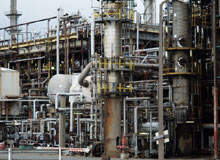
Established in 1968, the Lindsey oil refinery is wholly owned by Total, and is located five miles from the Humber River in North Lincolnshire, UK. The plant is the country’s third-largest oil refinery, producing nearly 10 million tonnes of crude a year.
Total acquired the Lindsey refinery from Fina in 1999. The plant has undergone several expansions in its time, the latest in 2007, when the company began the construction of a new hydrodesulphurisation unit and a hydrogen production unit.
In June 2010, an explosion at the refinery’s crude oil distillation unit killed an oil worker and injured two other members of staff. In April 2010, it was reported that Total was considered selling the Lindsey complex due to fragile demand. Total also aims to cut its UK production by 500,000bpd by 2011.
Lindsey oil refinery design
Spread across 500 acres, the plant has an altitude of 12m and is equipped with a 130m chimney. The plant comprises a distillation unit, vacuum distillation, thermal cracker, fluid catalytic cracker, catalytic reformer, MTBE unit, a desulphurisation unit, a gas recovery unit, isomerisation and polypropylene splitter, alkylation unit and a visbreaker. These units were added periodically between 1969 and 2006.
Lindsay output
The Lindsay refinery has the capacity to process nearly ten million tonnes of crude a year. Thanks to some of the highly advanced refining and conversion processes, the refinery is capable of processing 45 different kinds of crude.
In its total capacity, the refinery processes 30% diesel, 25% petrol, 17% LPG and speciality products, 15% fuel oil and bitumen and 13% kerosene and jet fuel. It can also produce 35 finished products at a processing capacity of 200,000bpd.
Pipeline route
The plant delivers refined products via two pipelines, one of which is a 150km high-pressure oil pipeline linking the refinery with the Buncefield terminal, which is located on the eastern side of Hemel Hempstead. Named the Fina line, this pipeline is routed through the berths at the port of Immingham, the largest UK port, which can handle craft of up to 100,000dwt.
The pipeline runs parallel to the western boundary of the British Pipeline Agency site. A major part of the pipeline is laid underground, under a metal grill enclosed in a bunded structure. The above-ground section that connects the west London pipeline to Heathrow, is also enclosed within a metal grill. The BPA is linked to the pipeline through its southern end.
The second pipeline transports aviation fuel from the Colnbrook rail terminal to Heathrow Airport. Named after the terminal, the Colnbrook pipeline is a medium-pressure pipeline with a diameter of 12in. It is constructed of welded steel and has been laid at a depth of minimum 1m soil cover.
Feedstock
Between 85% and 95% of the Lindsay refinery’s feedstock is sourced from the North Sea. Its close proximity to the Humber River enables the plant to take advantage of any fresh discoveries in the North Sea.
Expansion
In 2007, Total embarked on a £300m refinery expansion programme to increase its high-sulphur crude processing capacity. The expansion includes the construction of a hydrodesulphurisation (HDS 3) unit and a hyDrogen production unit designed to enhance the plant’s capacity for processing high-sulphur crude from 10% to nearly 70%. The refinery will also have a steam methane reformer (SMR) that will increase the refinery’s capacity of producing low-sulphur diesel.
The units were scheduled to be commissioned in 2009, but were delayed until spring 2010 due to workers’ strike. The project was further delayed due to the discovery of asbestos at the complex, following a fire explosion accident. The hydrodesulphurisation unit will produce one million tonnes of crude a year, when operational.
The contract for the expansion was awarded to Jacobs Engineering. Additional works were awarded to Italian construction company IREM, which created an uproar in the UK as several local employees of the project were replaced and left jobless.
Strike
In January 2009, nearly 800 local Lindsey oil refinery workers went on strike to protest against the appointment of IREM. The move was followed by the sacking of more than 900 refinery staff in June that year.
After attracting considerable media attention for nearly six months, the dispute was resolved on 29 June 2009 when the local workers were allowed to return to work. The strike resulted in a loss of £85m to the company.


